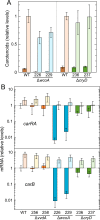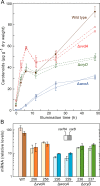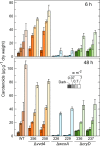The flavoproteins CryD and VvdA cooperate with the white collar protein WcoA in the control of photocarotenogenesis in Fusarium fujikuroi
- PMID: 25774802
- PMCID: PMC4361483
- DOI: 10.1371/journal.pone.0119785
The flavoproteins CryD and VvdA cooperate with the white collar protein WcoA in the control of photocarotenogenesis in Fusarium fujikuroi
Abstract
Light stimulates carotenoid biosynthesis in the ascomycete fungus Fusarium fujikuroi through transcriptional activation of the structural genes of the pathway carRA, carB, and cart, but the molecular basis of this photoresponse is unknown. The F. fujikuroi genome contains genes for different predicted photoreceptors, including the WC protein WcoA, the DASH cryptochrome CryD and the Vivid-like flavoprotein VvdA. We formerly found that null mutants of wcoA, cryD or vvdA exhibit carotenoid photoinduction under continuous illumination. Here we show that the wild type exhibits a biphasic response in light induction kinetics experiments, with a rapid increase in carotenoid content in the first hours, a transient arrest and a subsequent slower increase. The mutants of the three photoreceptors show different kinetic responses: the wcoA mutants are defective in the rapid response, the cryD mutants are affected in the slower response, while the fast and slow responses were respectively enhanced and attenuated in the vvdA mutants. Transcriptional analyses of the car genes revealed a strong reduction of dark and light-induced transcript levels in the wcoA mutants, while minor or no reductions were found in the cryD mutants. Formerly, we found no change on carRA and carB photoinduction in vvdA mutants. Taken together, our data suggest a cooperative participation of WcoA and CryD in early and late stages of photoinduction of carotenoid biosynthesis in F. fujikuroi, and a possible modulation of WcoA activity by VvdA. An unexpected transcriptional induction by red light of vvdA, cryD and carRA genes suggest the participation of an additional red light-absorbing photoreceptor.
Conflict of interest statement
Figures









Similar articles
-
Carotenoid Biosynthesis in Fusarium.J Fungi (Basel). 2017 Jul 7;3(3):39. doi: 10.3390/jof3030039. J Fungi (Basel). 2017. PMID: 29371556 Free PMC article. Review.
-
Light-mediated participation of the VIVID-like protein of Fusarium fujikuroi VvdA in pigmentation and development.Fungal Genet Biol. 2014 Oct;71:9-20. doi: 10.1016/j.fgb.2014.08.004. Epub 2014 Aug 19. Fungal Genet Biol. 2014. PMID: 25154020
-
Light-dependent functions of the Fusarium fujikuroi CryD DASH cryptochrome in development and secondary metabolism.Appl Environ Microbiol. 2013 Apr;79(8):2777-88. doi: 10.1128/AEM.03110-12. Epub 2013 Feb 15. Appl Environ Microbiol. 2013. PMID: 23417004 Free PMC article.
-
The White Collar protein WcoA of Fusarium fujikuroi is not essential for photocarotenogenesis, but is involved in the regulation of secondary metabolism and conidiation.Fungal Genet Biol. 2008 May;45(5):705-18. doi: 10.1016/j.fgb.2007.12.003. Epub 2007 Dec 15. Fungal Genet Biol. 2008. PMID: 18203635
-
Fusarium Photoreceptors.J Fungi (Basel). 2023 Mar 4;9(3):319. doi: 10.3390/jof9030319. J Fungi (Basel). 2023. PMID: 36983487 Free PMC article. Review.
Cited by
-
Comparative transcriptomic analysis unveils interactions between the regulatory CarS protein and light response in Fusarium.BMC Genomics. 2019 Jan 21;20(1):67. doi: 10.1186/s12864-019-5430-x. BMC Genomics. 2019. PMID: 30665350 Free PMC article.
-
Impact of the White Collar Photoreceptor WcoA on the Fusarium fujikuroi Transcriptome.Front Microbiol. 2021 Jan 18;11:619474. doi: 10.3389/fmicb.2020.619474. eCollection 2020. Front Microbiol. 2021. PMID: 33574802 Free PMC article.
-
A light life together: photosensing in the plant microbiota.Photochem Photobiol Sci. 2021 Mar;20(3):451-473. doi: 10.1007/s43630-021-00029-7. Epub 2021 Mar 1. Photochem Photobiol Sci. 2021. PMID: 33721277 Review.
-
Carotenoid Biosynthesis in Fusarium.J Fungi (Basel). 2017 Jul 7;3(3):39. doi: 10.3390/jof3030039. J Fungi (Basel). 2017. PMID: 29371556 Free PMC article. Review.
-
Genome sequencing and comparative genomics reveal insights into pathogenicity and evolution of Fusarium zanthoxyli, the causal agent of stem canker in prickly ash.BMC Genomics. 2024 May 21;25(1):502. doi: 10.1186/s12864-024-10424-w. BMC Genomics. 2024. PMID: 38773367 Free PMC article.
References
-
- Hoffmeister D, Keller NP. Natural products of filamentous fungi: enzymes, genes, and their regulation. Nat Prod Rep. 2007;24: 393–416. - PubMed
-
- Desjardins AE, Proctor RH. Molecular biology of Fusarium mycotoxins. Int J Food Microbiol. 2007;119: 47–50. - PubMed
-
- Rademacher W. Gibberellins In: Anke T, editor. Fungal biotechnology. New York: Chapman & Hall; 1997. pp. 193–205.
-
- Avalos J, Cerdá-Olmedo E, Reyes F, Barrero AF. Gibberellins and other metabolites of Fusarium fujikuroi and related fungi. Curr Org Chem. 2007;11: 721–737.
Publication types
MeSH terms
Substances
LinkOut - more resources
Full Text Sources
Other Literature Sources

